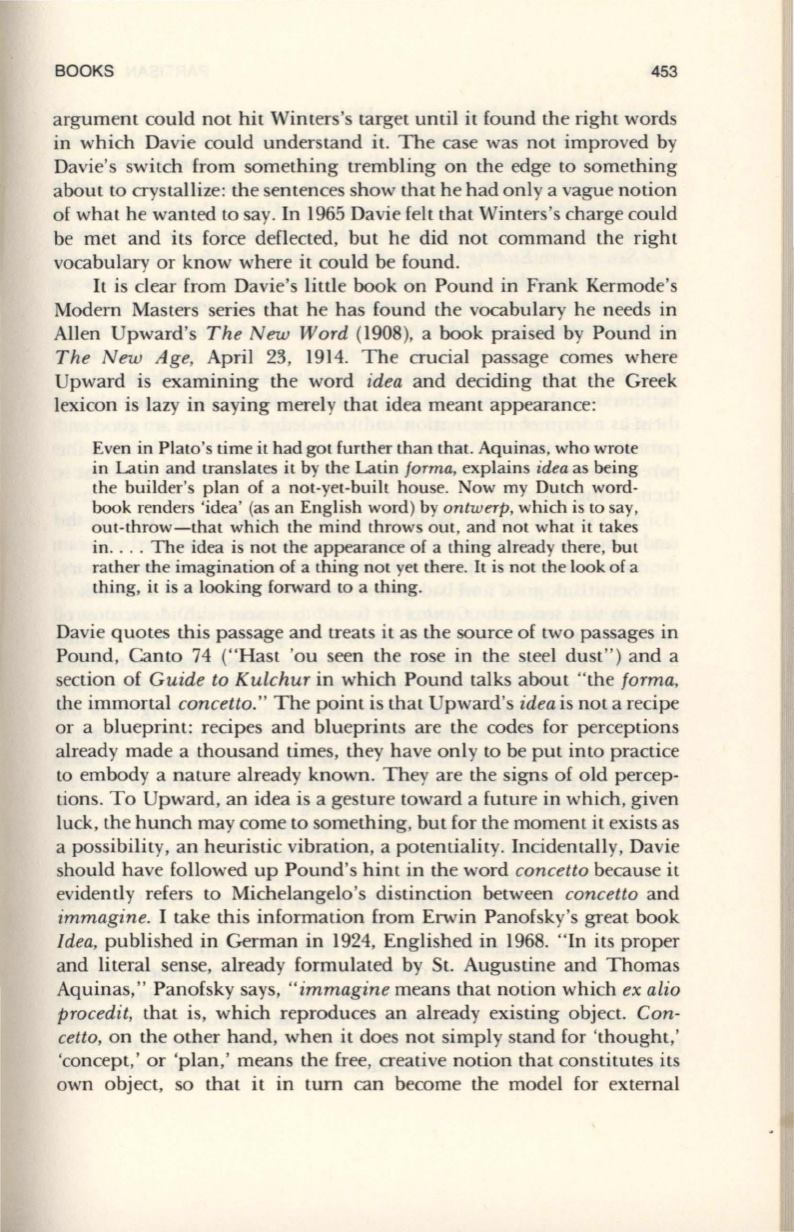
BOOKS
453
argument could not hit Winters's target until it found the right words
in which Davie could understand it. The case was not improved by
Davie's switch from something trembling on the edge to something
about to crystallize: the sentences show that he had only a vague notion
of what he wanted to say.
In
1965 Davie felt that Winters's charge could
be met and its force deflected, but he did not command the right
vocabulary or know where it could be found.
It
is clear from Davie's little book on Pound in Frank Kermode's
Modern Masters series that he has found the vocabulary he needs in
Allen Upward's
The New Word
(1908), a book praised by Pound in
The New Age,
April 23, 1914. The crucial passage comes where
Upward is examining the word
idea
and deciding that the Greek
lexicon is lazy in saying merely that idea meant appearance:
Even in Plato's time it had got further than that. Aquinas, who wrote
in Latin and translates it by the Latin
forma,
explains
idea
as being
the builder's plan of a not-yet-built house. Now my Dutch word–
book renders 'idea' (as an English word) by
antwerp,
which is to say,
out-throw-that which the mind throws out, and not what it takes
in.... The idea is not the appearance of a thing already there, but
rather the imagination of a thing not yet there.
It
is not the look of a
thing, it is a looking forward to a thing.
Davie quotes this passage and treats it as the source of two passages in
Pound, Canto 74 ("Hast 'ou seen the rose in the steel dust") and a
section of
Guide to Kulchur
in which Pound talks about "the
forma,
the immortal
concetto."
The point is that Upward's
idea
is not a recipe
or a blueprint: recipes and blueprints are the codes for perceptions
already made a thousand times, they have only to be put into practice
to embody a nature already known. They are the signs of old percep–
tions. To Upward, an idea is a gesture toward a future in which, given
luck, the hunch may come to something, but for the moment it exists as
a possibility, an heuristic vibration, a potentiality. Incidentally, Davie
should have followed up Pound's hint in the word
concetto
because it
evidently refers to Michelangelo's distinction between
concetto
and
immagine.
I take this information from Erwin Panofsky's great book
Idea,
published in German in 1924, Englished in 1968. "In its proper
and literal sense, already formulated by St. Augustine and Thomas
Aquinas," Panofsky says,
"immagine
means that notion which
ex alio
procedit,
that is, which reproduces an already existing object.
Con–
cetto,
on the other hand, when it does not simply stand for 'thought,'
'concept,' or 'plan,' means the free, creative notion that constitutes its
own object, so that it in turn can become the model for external


